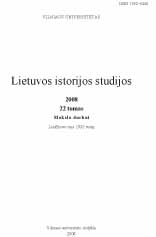Suklastota istorija: sovietų totalitarizmas ir partizanų karo prisiminimas
The Fake History: Soviet Totalitarianism and the Memory of the Guerrilla War
Author(s): Bernardas GailiusSubject(s): History
Published by: Vilniaus Universiteto Leidykla
Summary/Abstract: The historiography of the Lithuanian guerrilla war of 1944–1953 is usually considered to be wide. However the same may not be applied to the integration of the guerrilla war into the historical culture of the contemporary Lithuania. The variety of opinions and interpretations indicates that there exists no traditional understanding of the war. That also makes it impossible for any of the positions to be regarded as “critical” or “revisionist” as there is nothing to revise or criticize. This feature makes the guerrilla war exceptional of most historical events and requires some scientific explanation. The purpose of this article is to find one. The term “historical culture” was formulated by the German historian Jörn Rüsen. It defines the role of the history in organizing the worldview of the society and forming its identity. Therefore the historical culture includes all stages of history telling and writing – from family to university. The key element of the historical culture is historical narrative. J. Rüsen distinguishes four types of narratives: the traditional narrative, the exemplary narrative, the critical narrative and the genetic narrative. The interaction of these types of narratives defines the dynamics of the historical culture. After some important historical event the traditional and the exemplary narratives come first. They incorporate the event into the historical tradition of the society. Later the critical narratives appear that challenge the tradition. Finally, the genetic narratives help to grasp the changes of the tradition itself. This scheme does not work with the Lithuanian guerrilla war of 1944–1953. The systematic soviet repressions were aimed at the complete destruction of the Lithuanian social pattern. They prevented the traditional and the exemplary narratives from appearing. There were some stories and memoirs of the guerrilla fighters and there supporters, but these did not spread because of terror. People were silenced and then introduced with the soviet narrative, which may only be defined as quasi historical, because it was a part of the propaganda. Imitating the “popular” and the “scientific” approaches the soviet regime spread its narrative and constructed the quasi historical culture, which was itself a part of the “fictious world of stability” as the philosopher Hannah Arendt described it. This way the Lithuanian society was forced to live with the fake history.
Journal: Lietuvos istorijos studijos
- Issue Year: 2008
- Issue No: 22
- Page Range: 88-103
- Page Count: 16
- Language: Lithuanian

